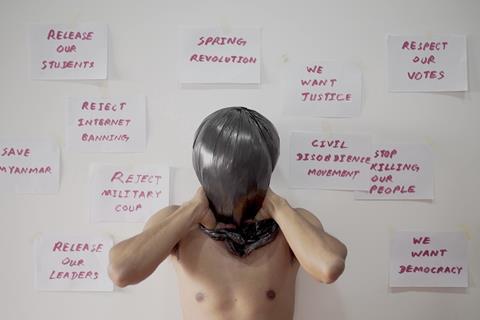An uneven but urgent doc-fiction report from Myanmar’s frontline

Dir/scr: The Myanmar Film Collective. Myanmar/The Netherlands/Norway. 2022. 70 mins.
Premiering at the 2022 Berlinale just over a year after the military coup and crackdown that ended Myanmar’s highly tentative march towards democracy, this film’s most admirable quality is its very existence. The collective work of ten Burmese filmmakers who have chosen not to reveal their identities for obvious reasons, it is a defiant act of creative resistance, showing that cinema can be made even in the most difficult and dangerous of circumstances.
It is a defiant act of creative resistance
It’s clear that this documentary-fiction hybrid is a collage, assembled by mixing ‘live’ footage of the coup and protests that followed with more consciously artistic contributions, most of them in the nature of cinematic short stories or diary entries. How many of the often shocking street-shot documentary contributions were filmed by members of the collective, or simply sourced by them, is unclear, and we can’t turn to the end credits to find out, as aside from the names of three co-production partners, there’s aren’t any. Even foreign crew members, we’re informed by a closing caption, chose not to be listed out of solidarity with their Burmese colleagues.
The result is a film that, unlike another recent anonymous collective’s report from the frontline – the 2020 documentary Inside the Red Brick Wall, which charted the police siege of Hong Kong’s Polytechnic University – lacks a unifying narrative and is something of an uneven assortment. Some of the weaker ‘fictional’ inserts feel a little like earnest film student shorts, and arguably hitch an emotional ride on the dramatic intensity of the more harrowing real-life footage. But taken as a whole, Myanmar Diaries is both an urgent denunciation of human rights abuses and a thought-provoking work of art, as it suggests that, in such extreme situations, ‘pure’ documentary can fall short as it comes up against the impenetrable wall of human cruelty. In this, the film is a very distant cousin of Joshua Oppenheimer’s The Act of Killing. With its lo-fi production values, Myanmar Diaries won’t achieve anything like that Oscar-nominated film’s outreach, but it will see further festival exposure at the least.
The opening scene is one of very few that many viewers will recognize – shot on the day of the coup, 1 February 2021, it shows a Burmese aerobics instructor working out to an Indonesian dance track as a convoy of military vehicles races towards parliament in the background. After it went viral, some questioned the ‘accidental’ nature of the video, seeing it instead as a deeply ironic act of protest. However, what follows doesn’t blur what’s real and what isn’t in the postmodern way this set-up suggests – instead it attempts, successfully for the most part, to find an emotional connection between the two.
For all that, it’s the documentary footage, most of it shot on smartphones during the civilian protests and military crackdown that followed the coup, which has the deepest impact. Three short scenes stand out. One shows an arrest from the cameraman’s point of view, as he attempts to reason with the soldiers who have come to take him away. Another tracks a brave woman in her sixties as she harangues a convoy of young soldiers sent to quell the uprising. The third, and most emotionally devastating, comes at the film’s midpoint. Filmed from outside a small family home, it shows a pack of policemen piling in to arrest a woman as her daughter pleads tearfully with them to leave her alone. The undercurrent of jeopardy and risk present in most of these street-shot scenes is hammered home when one of the policemen eventually turns on the cameraperson.
Interspersed with these breathless slices of everyday courage, the film’s fictional inserts range from a ghost story in which a man falls asleep while watching Big Bang Theory on TV and is visited by a succubus that squats on his chest, to a segment in which a girl plans to tell her fiancé she’s pregnant – but the announcement is foiled by the force majeure of a police raid on the protestors’ squat where the boyfriend is living. Only the final section feels like a really convincing attempt to meld Myanmar Diaries’ two strands. Shot somewhere in the countryside, where a group of protestors are undergoing military training, it slowly slips into a dreamlike march through the jungle, accompanied by a Malick-esque voiceover that ends with the plaintive appeal “Can you hear us?’”.
Production company: Zindoc
International sales: Autlook Film Sales, Salma Abdalla, salma@autlookfilms.com






![The Brightest SunScreen[Courtesy HKIFF]](https://d1nslcd7m2225b.cloudfront.net/Pictures/274x183/3/5/0/1448350_thebrightestsunscreencourtesyhkiff_312678.jpg)















![The Brightest SunScreen[Courtesy HKIFF]](https://d1nslcd7m2225b.cloudfront.net/Pictures/100x67/3/5/0/1448350_thebrightestsunscreencourtesyhkiff_312678.jpg)

